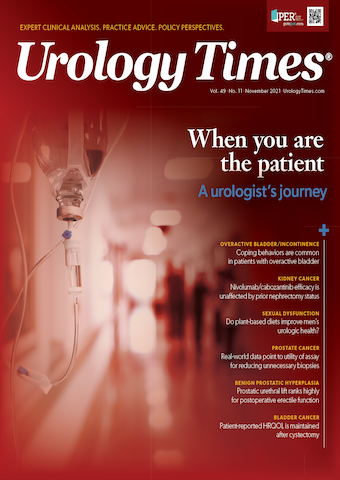Patient-reported HRQOL is maintained after cystectomy
"This study provides credible support for the expectation that post-RC HRQOL should recover and improve over the first 2 years after RC, and provides a benchmark for comparisons with future bladder preservation strategies," writes Badar M. Mian, MD.
Badar M. Mian, MD

Radical cystectomy (RC) and urinary diversion are arguably the most life-altering therapeutic interventions undertaken by urologists. From the patient’s perspective, matters related to survivorship and health-related quality of life (HRQOL) may be as important as cancer control. The implication of postoperative HRQOL and functional status are such that most patients are initially reluctant to consider this surgery, with some refusing it altogether in favor of potentially less effective therapies. There has been a lack of prospective studies with longitudinal follow-up of the impact of RC on HRQOL, especially when compared to the preoperative, baseline features.
Many concerns about HRQOL are addressed in a recent report by Clement et al.1 The authors conducted a prospective study to collect data using 14 patient-reported outcome measures and semistructured interviews over a 2-year follow-up period. Their aim was to describe the HRQOL and some functional outcomes following RC, to compare pre-RC HRQOL between patients undergoing different types of urinary diversions, and to quantify baseline differences in outcomes associated with the clinical selection biases for various diversion types. Several tools were utilized, including the European Organisation for Research and Treatment of Cancer Quality of Life Questionnaire, to assess various domains such as physical, emotional, social, urinary bowel, sexual, and global QOL. Because of the differences in selection criteria for continent diversion or ileal conduit, the patterns of recovery for each diversion type were reported separately.
Of the 462 patients enrolled from 2008 to 2014, 411 were evaluable for this report. Most procedures were performed using open technique (88%). In terms of survey participation, 292 (71%) completed the baseline questionnaires pre-RC and 196 (48%) completed follow-up surveys at 24 months. Only 178 (43%) received neoadjuvant chemotherapy. There were significant differences in baseline characteristics among patients undergoing continent diversion and ileal conduit. The continent diversion patients, compared with the ileal conduit cohort, were younger, healthier, employed, , and likely to have better renal function, nerve-sparing procedure and neoadjuvant chemotherapy.
In the continent diversion cohort, global QOL domain scores remained similar to the baseline score of 74 at 3 months and gradually improved to 80 at 12 months. In the ileal conduit cohort, scores at 3 months postoperatively were similar to baseline, then gradually increased slightly by 24 months. The mobility and activity scores decreased by only 5 points (scale, 0 to 100) in the continent diversion cohort at 3 months but returned to near preoperative levels by 12 months. In patients with ileal conduit, a similar early decrease of 5 points was noted, but function did not recover to baseline during follow-up.
When assessing the ability to perform work or other activities, patients with an ileal conduit were near their baseline by 24 months, and those with a continent diversion had improved to a higher score than the baseline pre-RC scores. In social functioning domains, no decrease, and an actual increase (by 10 points) from baseline, were reported in the continent diversion cohort at 12 months. In those with an ileal conduit, the initial mean decrease (from 81 to 77) by 6 months improved to near baseline by 24 months.
The bowel function index decreased modestly by 4 points at 6 months in continent diversion patients and then remained stable. Among the ileal conduit cohort, the scores remained within 2 points of baseline throughout follow-up. Despite using a much longer bowel segment in continent diversion, there was no significant difference in bowel function among the diversion types. Body image scores for the ileal conduit cohort decreased by 10 points at3 and 6 months and did not improve over time, whereas the scores remained unchanged in continent diversion cohort over time.
The mean scores on the sexual function domain in ileal conduit patients decreased from 37 at baseline to 27 at 6 months, with no further improvement. In continent diversion patients (nerve-sparing RC was more common), scores decreased from 48 to 28 at 6 months, recovered to 36 by 12 months, and showed no further improvement. In a subset of patients receiving continent diversion and nerve or vagina sparing, the scores decreased from 51 to 30 at 6 months, with recovery to 45 by 24 months.
It is important to note that any difference reported in HRQOL between continent diversion and ileal conduit are likely not related to the diversion itself but rather due to the differences in selection criteria (age, health, social status, renal function, nerve-sparing technique). Thus, one cannot conclude that one type of urinary diversion is associated with a better HRQOL over the other.
The authors noted that although there was an observed decrease in some physical health domains for up to 6 months, most HRQOL measures had returned to or exceeded baseline by 24 months except sexual function. For the psychosocial domains, scores remained stable or improved over time, although patients receiving ileal conduit showed decreases in body image. These data and previous studies suggest that there is a decrease in the physical functioning and some other QOL domains at 3 and 6 months, which tends to recover to baseline or at times even better than baseline.
Because this study includes patients from a single high-volume center with embedded resources, it is not clear whether similar outcomes can be reproduced at other hospital. However, studies have demonstrated that RC surgical volume is an important determinant of oncologic and functional outcomes, and one might expect most tertiary referral centers to be able to deliver similar HRQOL outcomes. Also, the mechanisms by which some HRQOL domains improved beyond the preoperative scores at 12 to 24 months are not discussed. Were these patients experiencing physical (or psychological) symptoms from the bladder cancer or the diagnostic procedures or systemic therapy at the time of the survey which could have lowered their reported baseline HRQOL scores?
A few studies have reported poor HRQOL after RC and diversion, which has prompted a more vigorous pursuit of nonsurgical therapies such as trimodal combination of endoscopic resection, chemotherapy, and radiation therapy. Previous post-RC HRQOL studies generally lacked longitudinal follow-up, not prospectively designed, and did not include baseline QOL data. This study provides credible support for the expectation that post-RC HRQOL should recover and improve over the first 2 years after RC, and provides a benchmark for comparisons with future bladder preservation strategies.
Reference
1. Clements MB, Atkinson TM, Dalbagni GM, et al. Health-related quality of life for patients undergoing radical cystectomy: results of a large prospective cohort. Eur Urol. Published online October 8, 2021. doi:10.1016/j.eururo.2021.09.018

Speaking of Urology Podcast: Dr. Ritch and Dr. Katz discuss new bladder cancer management app
December 7th 2021“It's not a replacement for clinical judgment, obviously. But at the end of the day, the idea is that it shows you what your next steps are based on what the American Urological Association and [Society of Urologic Oncology] guidelines are for non-muscle invasive bladder cancer,” Chad R. Ritch, MD, MBA, FACS.
Cell therapy TARA-002 shows initial promise in NMIBC
April 9th 2024"This encouraging anti-tumor activity coupled with a favorable safety profile and mode of administration that is both convenient and familiar to urologists indicates that, if confirmed in future studies, TARA-002 could potentially play a meaningful role in NMIBC treatment in the future," says Timothy D. Lyon, MD.
